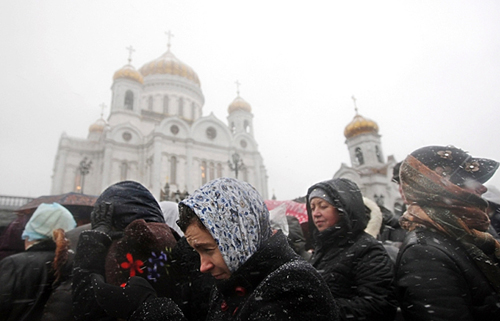 Waiting outside the Cathedral. Photo:Maxim Shipenkov, EPA
Waiting outside the Cathedral. Photo:Maxim Shipenkov, EPA It began with a heartfelt request by the Russian Fund St. Andrew the First-called to the abbot of Vatopedi Monastery on Mt. Athos, Archimandrite Ephraim, and a blessing from His Holiness Patriarch Kirill of Moscow and All Russia, who announced on Russian television:
“Thousands of pilgrims visit Vatopedi Monastery just to pray before this holy relic, to kiss this fragment of the garments of the Most Holy Theotokos. People pray before the Cincture of the Theotokos for healing from illnesses. Many incurable illnesses, including oncology, recede at people’s fervent prayers before this holy relic. In Vatopedi Monastery the monks make small copies of this Cincture, and we know that some women who suffer from infertility wear these little sashes. If to this is added repentance, fervent prayer, and strong faith, then this prayer reaches the throne of the Heavenly Queen; many incidents have been recorded of women subsequently being able to have children.
“This is a serious problem for our country (Russia), and an important subject. I hope very much that the men and women who visit this holy relic while it is on Russian soil will fervently pray before it, venerate it, and ask the Heavenly Queen for help in their lives, including for the birth of children. May the presence of the Cincture of the Theotokos help many to understand the power of Divine grace and the heavenly world’s closeness to us.”
On November 20, Patriarch Kirill celebrated his 65th birthday. He and the primates of several local Churches served Divine Liturgy in the cathedral, and the Holy Cincture’s presence lent even more solemnity to the service attended by thousands of people.
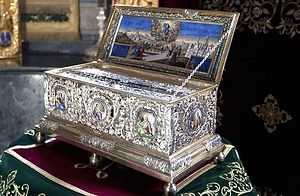 The Sacred Cincture of the Theotokos in the altar of the church in Vatopedi Monastery, Mt. Athos. Photo:www.pemptousia.ru
The Sacred Cincture of the Theotokos in the altar of the church in Vatopedi Monastery, Mt. Athos. Photo:www.pemptousia.ru The relic has been piously preserved in Vatopedi Monastery since the fourteenth century. Even the Turkish Sultans recognized its miraculous qualities. Therefore in 1872, when Istanbul (the former Byzantine Constantinople) was beset by a cholera epidemic, Sultan Abdul-Aziz requested that the Cincture be brought to the city, and he sent a ship to take it. No sooner had the ship approached the city when the epidemic abated. The amazed Muslim Sultan ordered the relic brought to his palace for veneration.
Now the relic has been brought to Russia by Archimandrite Ephraim and twenty monks from Vatopedi. Transportation and logistics were organized by the Fund of St. Andrew the First-Called. The response has been phenomenal. As of Saturday, November 26, nearly two million Russians have come to cathedrals in major cities to recieve their grace of the Most Holy Theotokos.The original route included arrival in St. Petersburg (were Prime Minister Vladimir Putin met the delegation at the airport) on October 20, Ekaterinburg, Norilsk, Vladivostok, Krasnoyarsk, Diveyevo, Saransk, Samara, Rostov-on-the-Don, Kaliningrad, and finally Moscow, from which the delegation will return to Mt. Athos. But there were so many people in this vast country who ardently desired to venerate this holy relic of the Mother of God that more cities were added to the list: Tiumen, Volgograd, and Stravropol. Even the number of days in Moscow was extended by decision of the Vatopedi brotherhood when they understood how many people were arriving to venerate.
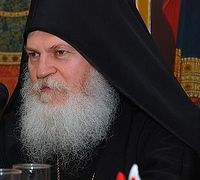 Archimandrite Ephraim, abbot of Vatopedi Monastery. Photo: A. Pospelov, Pravoslavie.ru
Archimandrite Ephraim, abbot of Vatopedi Monastery. Photo: A. Pospelov, Pravoslavie.ru “We have come from the Holy Mountain of Athos—a place of asceticism, silence, prayer, repentance, the Protectress and Directress of which is the Mother of God. The Holy Mountain is still called the Garden of the Mother of God, and therefore all the monasteries are dedicated to the Theotokos.
“Vatopedi monastery is the only monastery in the world that is adorned with seven miracle-working icons of the Mother of God, and the Honorable Cincture (Cincture, in Greek, Zoni) of the Most Holy Theotokos. We have three reliquary cases with portions of the holy Cincture, given to the monastery by an emperor and a prince. The first was John Cantacuzen, the Byzantine emperor, who was closely connected with the monastery: his spiritual father lived there, the saint of our Orthodox Church, Savva the fool-for-Christ (I recommend you all read his life). This saint lived several years in Constantinople before coming to the monastery and the emperor understood that this was a man of God, thus taking him as his spiritual counselor. They say that the emperor himself became a monk in our Vatopedi monastery at the end of his life. The second person to give a portion of the holy Cincture to the monastery was Grand Prince Lazar of Serbia, who suffered for the sake of Christ, and is now the protector and great martyr of the Serbian Orthodox Church.
“Apparently the Theotokos chose Vatopedi Monastery to be particularly adorned by her mercy: two donors who did not even know each other were enlightened by grace at the same time and gave this great holy relic to one and the same monastery. Our spiritual father, Elder Joseph of Vatopedi, who reposed two years ago, often said to us: ‘Where else would it please the Theotokos to preserve her holy Cincture but on the Holy Mountain, which is a place of purity, chastity, obedience—a place of virginity?’ You know, the Cincture was symbolic even under the Law of Moses. We know from the Old Testament that virgins wove themselves Cinctures, and when the official wedding day arrived, a virgin would give this Cincture to her husband as a symbol of her virginity.
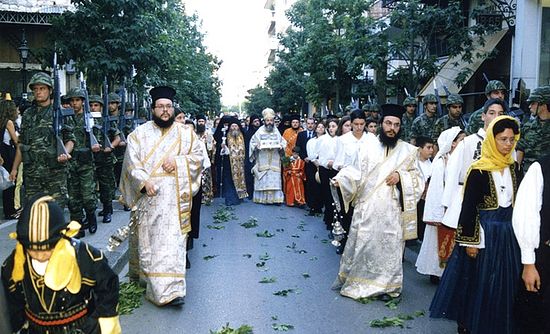 The Holy Cincture in procession in a town in Greece. Photo: www.pemptousia.ru
The Holy Cincture in procession in a town in Greece. Photo: www.pemptousia.ru 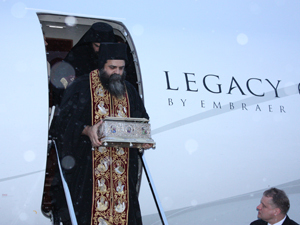 The Holy Cincture arrives in Volgograd.
The Holy Cincture arrives in Volgograd. “We once met a family in Athens—today they are elderly. They told us how sixty years ago the Cincture was brought to Athens and it was in their home. They remembered this for so many years, were filled with joy over this, told people about it, and were filled with grace… When the Cincture was again in Athens twelve years ago it was placed on a table, and the tablecloth on which it lay still exudes a fragrance. I pray that the grace of the Theotokos would fill your hearts also, and that you would understand what a great honor it is that we are Orthodox Christians, members of the Church, and children of God.”
This outpouring of grace of the Mother of God was indeed felt throughout Russia over the period of the Holy Cincture’s presence here. Indeed all the Orthodox cannot but hold our Lord’s Mother dear—this is not a theory or a dogma but a fact. But perhaps nowhere was the Cincture so sought after as it was in the capital city of Moscow, where not only Muscovites endured many hours of waiting in the cold, but also people from around the country. Moscow is the hub of the transportation wheel in this highly centralized nation, and so for people not living close to the other cities on the delegation’s route, it was easier to come here to pray before the relic. The Cathedral of Christ the Savior, a beloved Moscow religious landmark, hosted the precious Cincture during its stay here.
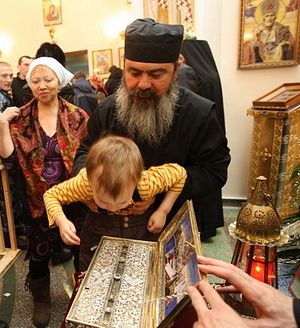 Venerating the Holy Cincture in Samara.
Venerating the Holy Cincture in Samara. It is no trifling matter to wait as long as two full days in line on a wintry street but these determined people continually felt the care of the Mother of God and the organizers. Impromptu Akathists sounded here, there and everywhere, punctuated by heartfelt sighs of “O Most Holy Mother of God save us!” A visit to the Cathedral was truly a visit to Holy Russia—bearded old men leaning on canes, stout, all-enduring babushkas, mothers with their children, the poor, the blind, and the lame. Clergy led their flocks, monks and nuns were interspersed with and serving the many-thousand-fold worshippers. The uniformed police in their fur caps who guarded everyone’s safety even seemed more like angels than men. Moscow churches and monasteries saw a continual stream of people obviously fresh from provincial parts, carrying their bundles. Many described the experience as “Christmas, or Pascha”. It was like a combination of both of these great feasts—the joy of Pascha, the luminous warmth amidst the fluttering snowflakes of Christmas; the light amidst the darkness, the glorious protection of the Mother of God that lightens every burden. It was impossible to deny the feeling that the Most Holy Mother of God was close, was visiting and blessing her children; and as Father Ephraim said in Ekaterinburg, this blessing will undoubtedly last, and even mark a change in the life of the city, perhaps even the whole country.
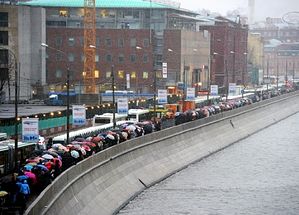 The queue to Christ the Savior Cathedral. Photo: RIA Novosti
The queue to Christ the Savior Cathedral. Photo: RIA Novosti Friday, November 25. It is clear to all that at the current pace, many will leave without receiving the blessing of venerating the Holy Cincture in the Christ the Savior Cathedral. The organizers make the decision to raise the sacred relic on an arc to allow the faithful to pass underneath it and prayerfully receive its grace. The newspapers report that although the line is no shorter, the speed of entry has increased. The organizers announce that they will continue to distribute ribbons blessed on the Holy Cincture even after the delegation’s departure.
Saturday, November 26. The waiting lines are still several kilometers long, and access to the Cathedral is due to close at 9:00 pm tomorrow. Again the Mt. Athos monks demonstrate their ascetical mercy and agree to extend the closing time to 4:00 am Monday…
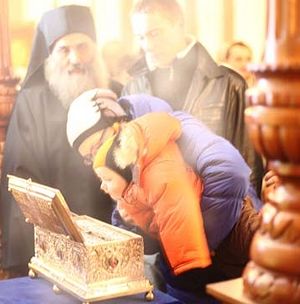 Photo: Nikita Nikitich for KP.RU
Photo: Nikita Nikitich for KP.RU 
